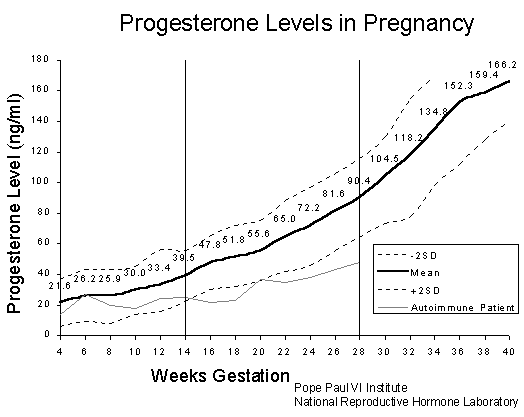Progesterone Levels During Pregnancy
Understanding the Importance of Progesterone in Gestation

Introduction
Progesterone is first produced by the corpus luteum of the ovary and production from this site is necessary for the first 8 weeks of pregnancy. From implantation of the embryo onwards for 40 weeks the placenta takes over the production of progesterone (see graph). The levels of progesterone increase dramatically throughout pregnancy. Progesterone production is necessary for the safe maintenance of pregnancy and all pregnancies will fail if progesterone production is too low.
Many women with infertility, implantation failures, and/or miscarriages produce low levels of progesterone as seen in the bottom line of the graph. These women require progesterone supplementation to bring them to safe levels (see the thick line on the graph, which indicates mean values and limits of two standard deviations of the mean). Based on our experience in treating autoimmune women, this supplementation must continue until the 16th week is completed.
Progesterone-like steroid medication has a variety of effects on the immune system. This type of medication:
- Blocks inflammation that can lead to scarring and damage to the placenta
- Blocks the T cells and the B cells (lymphocytes) that can cause rejection of the placenta
- Blocks the natural killer cells from releasing factors such as tumor necrosis factor (TNF) that can damage the placenta and the lining of the uterus
- Prevents lymphocytes from wandering into the placenta, sticking there, and doing damage
- Causes an increase in HCG production by the placenta, and HCG and progesterone block the killing power of NK cells
- Prevents prostaglandin production by the uterus and stops contractions from occurring
- Causes the cervix to produce a cervical plug that is rich in antibodies, which prevent germs and viruses from gaining access to the baby and the placenta
When progesterone supplementation is given to a mother, its half-life in the blood is very short. In four minutes it begins to be excreted rapidly into the urine. The most efficient route to take progesterone to ensure the best blood levels and the longest survival of the progesterone in the blood is to use vaginal suppositories. The next best route of administration is to take injections of progesterone. The least effective is to take the progesterone by mouth.
The information contained in this article is not intended to be a medical diagnosis, treatment, or medical advice in any way, as it is general information and cannot be relied on without consultation with your physician. It is not intended nor is it implied to be a substitute for professional medical advice. As medical information can change rapidly, we strongly encourage you to discuss all health matters and concerns with your physician before embarking on new diagnostic or treatment strategies.